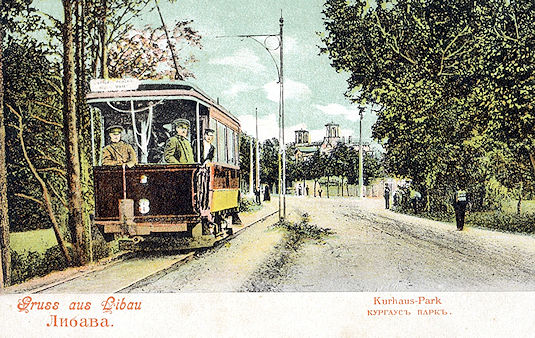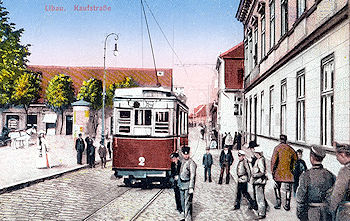

Libau is the German name for what is now Liepaja, the third largest city in the Baltic state of Latvia after Riga and Daugavpils. Lying in the west of the country, it gained its city rights in 1625 in what was then Courland, and passed to the Russian Empire in 1795. During the Crimean War, it was even occupied for a short time in 1854 by the Royal Navy. It was an important ice-free port for goods and passengers and the city grew in the 19th and 20th centuries. Latvia was occupied and annexed by the Soviet Union in 1940. From 1941, it was occupied by the Germans in WW2 until 1945 when it was recaptured by the Soviet Union Red Army. Latvia regained its full independence in 1991.
The city had decided on building an electric tramway in 1896 and a contract to build it was awarded to the Nürnberger Continental-Gesellschaft für Elektro-Unternehmen in 1899. A separate concession was signed with 'Nürnberger Continental-Gesellschaft Manaschewitsch' in which they could run the tramway for 40 years, but with an option for the city to buy it after 20 years. The electric tram line was made possible by the opening, in 1899, of the first Libau power plant, which makes it the oldest electric tramway in the Baltic States. It is now operated by the municipal company Liepajas tramvajs.
Test running started on 14 September 1899 and the first passengers were carried on 26 September. From the 14 October, two routes were ready totalling about 10.5km in length on metre gauge. The 'White' route ran northwards to the harbour at Karosta and the 'Green' route ran to the main railway station. In November 1899, both routes were extended to Alt-Libau, the old part of the city.
 Our main postcard of about 1904, published with serial no.3742 by Joseph Neuburger, shows tram no.8 alongside the Kurhaus Park. Trams 1-9 of 1899 were built by Herbrand and Co. in Cologne, with the typical open platforms of the period. In 1903, a further seven trams (nos. 10-16) were delivered by Herbrand but with enclosed platforms. Subsequently, some of the original series were rebuilt with enclosed platforms as seen in the slightly later postcard view (right) by an unknown publisher (ca.1912) of tram no.2 at the tram stop in Kaufstrasse (Kungu and Tirgonu Streets). Note the uniformed soldiers in this view although two others have been expunged from the left foreground of the picture, close to the camera, and replaced by the woman in a white dress on the pavement opposite!
Our main postcard of about 1904, published with serial no.3742 by Joseph Neuburger, shows tram no.8 alongside the Kurhaus Park. Trams 1-9 of 1899 were built by Herbrand and Co. in Cologne, with the typical open platforms of the period. In 1903, a further seven trams (nos. 10-16) were delivered by Herbrand but with enclosed platforms. Subsequently, some of the original series were rebuilt with enclosed platforms as seen in the slightly later postcard view (right) by an unknown publisher (ca.1912) of tram no.2 at the tram stop in Kaufstrasse (Kungu and Tirgonu Streets). Note the uniformed soldiers in this view although two others have been expunged from the left foreground of the picture, close to the camera, and replaced by the woman in a white dress on the pavement opposite!
In June 1941, the trams were withdrawn due to German bombardment of the city but services resumed in mid-July. In 1944, during the German occupation, the tramway overhead was removed so the tramway closed again. In November 1945, services were once again resumed.
In post-war years, the system was steadily changed, upgraded and extended. Modern rolling stock comprises Tatra KT4 SU and KT4 D type trams, including some second-hand ones from the former East Germany (Cottbus, Gera and Erfurt). In November 2020, the first of a new three-section, low-floor tram of type TMK 2300 was delivered from the Croatian consortium 'CroTram'. By September 2021, seven trams of this type (nos. 250-256) were in service, with up to seven more expected over the next few years. However, there is now only one route of just 6.9km, but there may be future extensions.
![]() Go to Postcard Of The Month Index
Go to Postcard Of The Month Index